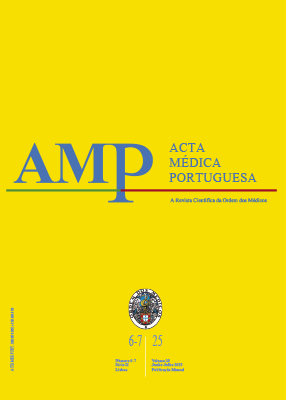Spinocerebellar Ataxia Type 27B (SCA27B): A Hereditary Ataxia in Portugal
DOI:
https://doi.org/10.20344/amp.22232Keywords:
Spinocerebellar Ataxias/diagnosis, Spinocerebellar Ataxias/genetics, PortugalAbstract
Spinocerebellar ataxia type 27B (SCA27B) is a recently discovered hereditary disease caused by (GAA)≥250 repeat expansion in the fibroblast growth factor 14 (FGF14) gene, and multiple studies have recognized it as one of the most common causes of autosomal dominant ataxia in the European population. We present the case of a 62-year-old Portuguese patient who developed a slowly progressive gait impairment associated with wide-base ataxic gait, dysarthria, left upper limb dysmetria, and dysdiadochokinesia. This pure cerebellar phenotype had an episodic worsening induced by intense physical activity and alcohol intake. The patient had an older brother with a late-onset cerebellar ataxia of unknown cause. Genetic testing detected a heterozygotic intronic FGF14 repeat expansion with complete penetrance (> 360 repeats), confirming the diagnosis of SCA27B. To our knowledge, we present the first reported case of SCA27B in the Portuguese population.
Downloads
References
Pellerin D, Danzi MC, Wilke C, Renaud M, Fazal S, Dicaire MJ, et al. Deep intronic FGF14 GAA repeat expansion in late-onset cerebellar ataxia. N Eng J Med. 2023;388:128-41. DOI: https://doi.org/10.1056/NEJMoa2207406
Pellerin D, Danzi MC, Renaud M, Houlden H, Synofzik M, Zuchner S, et al. Spinocerebellar ataxia 27B: a novel, frequent and potentially treatable ataxia. Clin Transl Med. 2024;14:e1504. DOI: https://doi.org/10.1002/ctm2.1504
Clément G, Puisieux S, Pellerin D, Brais B, Bonnet C, Renaud M. Spinocerebellar ataxia 27B (SCA27B), a frequent late-onset cerebellar ataxia. Rev Neurol. 2024;180:410-6. DOI: https://doi.org/10.1016/j.neurol.2024.03.007
Hengel H, Pellerin D, Wilke C, Fleszar Z, Brais B, Haack T, et al. As frequent as polyglutamine spinocerebellar ataxias: SCA27B in a large german autosomal dominant ataxia cohort. Mov Disord. 2023;38:1557-8. DOI: https://doi.org/10.1002/mds.29559
Satolli S, Rossi S, Vegezzi E, Pellerin D, Manca ML, Barghigiani M, et al. Spinocerebellar ataxia 27B: a frequent and slowly progressive autosomaldominant cerebellar ataxia—experience from an Italian cohort. J Neurol. 2024;271:5478-88. DOI: https://doi.org/10.1007/s00415-024-12506-x
Kartanou C, Mitrousias A, Pellerin D, Kontogeorgiou Z, Iruzubieta P, Dicaire M, et al. The FGF14 GAA repeat expansion in Greek patients with late-onset cerebellar ataxia and an overview of the SCA27B phenotype across populations. Clin Genet. 2024;105:446-52. DOI: https://doi.org/10.1111/cge.14482
Iruzubieta P, Pellerin D, Bergareche A, Albajar I, Mondragón E, Vinagre A, et al. Frequency and phenotypic spectrum of spinocerebellar ataxia 27B and other genetic ataxias in a Spanish cohort of late-onset cerebellar ataxia. Eur J Neurol. 2023;30:3828-33. DOI: https://doi.org/10.1111/ene.16039
Wirth T, Bonnet C, Delvallée C, Pellerin D, Bogdan T, Clément G, et al. Does spinocerebellar ataxia 27B mimic cerebellar multiple system atrophy? J Neurol. 2024;271:2078-85. DOI: https://doi.org/10.1007/s00415-024-12182-x
Ayala IN, Aziz S, Argudo JM, Yepez M, Camacho M, Ojeda D, et al. Use of riluzole for the treatment of hereditary ataxias: a systematic review. Brain Sci. 2022;12:1040. DOI: https://doi.org/10.3390/brainsci12081040
Yan H, Pablo JL, Pitt GS. FGF14 regulates presynaptic Ca2+ channels and synaptic transmission. Cell Rep. 2013;4:66-75. DOI: https://doi.org/10.1016/j.celrep.2013.06.012
Huang CS, Song JH, Nagata K, Yeh JZ, Narahashi T. Effects of the neuroprotective agent riluzole on the high voltage-activated calcium channels of rat dorsal root ganglion neurons. J Pharmacol Exp Ther. 1997;282:1280-90.
Downloads
Published
How to Cite
Issue
Section
License
Copyright (c) 2024 Acta Médica Portuguesa

This work is licensed under a Creative Commons Attribution-NonCommercial 4.0 International License.
All the articles published in the AMP are open access and comply with the requirements of funding agencies or academic institutions. The AMP is governed by the terms of the Creative Commons ‘Attribution – Non-Commercial Use - (CC-BY-NC)’ license, regarding the use by third parties.
It is the author’s responsibility to obtain approval for the reproduction of figures, tables, etc. from other publications.
Upon acceptance of an article for publication, the authors will be asked to complete the ICMJE “Copyright Liability and Copyright Sharing Statement “(http://www.actamedicaportuguesa.com/info/AMP-NormasPublicacao.pdf) and the “Declaration of Potential Conflicts of Interest” (http:// www.icmje.org/conflicts-of-interest). An e-mail will be sent to the corresponding author to acknowledge receipt of the manuscript.
After publication, the authors are authorised to make their articles available in repositories of their institutions of origin, as long as they always mention where they were published and according to the Creative Commons license.









